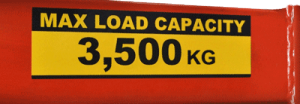Rated Capacity or Maximum Rated Capacity
 Standards bodies in the developed world now encourage the use of Rated Capacity for rating the lifting capacity of cranes, hoists and winches.
Standards bodies in the developed world now encourage the use of Rated Capacity for rating the lifting capacity of cranes, hoists and winches.
Rated Capacity is the maximum total load a crane can lift for a defined configuration. Rated Capacity is also known as the Maximum Rated Capacity (MRC) or Manufacturer’s Rated Capacity.
Rated Capacity is, (as defined in BS EN 13000:2004, Cranes – Mobile Cranes)
“load that the crane is designed to lift for a given operating condition (e.g. configuration, position of the load). For mobile cranes the mass (weight) of the hook block is part of the load”
Simply put, the Rated Capacity of a Mobile Crane is everything being lifted by the crane’s boom. This is referred to as the Gross Load of the crane where the Net Load is the actual mass being lifted.
With regards to most manufacturer’s Lifting Charts (used to calculate the Rated Capacity of crane in a certain configuration), the Gross Load includes the hook block, any jib extension stowed away on the boom (ie. not being used) and for some cranes with multi lift lines, any lines not actually required to lift the Net Load. The Rated Capacity of crane is influenced by extending booms, optional jigs, out riggers, counter weights, lift radius, lift angle and more depending on the complexity of the crane and required lift configuration. The nominal (advertised) Maximum Rated Capacity of a crane normally refers to the maximum Net Load the crane can lift under optimum conditions (shortest boom length, minium lift radius, optimum lift angle, out riggers extended, etc.)
The Rated Capacity for a piece of lifting equipment is set by the equipment’s manufacturer. Any requirement to “derate” (change the Rated Capacity) of a piece of equipment should only be done by a competent person (qualified engineer) and after consultation with its manufacturer.
Working Load and Working Load Limit
Standards bodies in the developed world now encourage the use of Working Load Limit (WLL) for lifting accessories like hooks, slings and shackles.
A Working Load is the
“load on the hook plus mass (weight) of the hook and block”
(as defined in BS EN 13000:2004, Cranes – Mobile Cranes).
This is a concise definition for a Working Load on a crane line, however it does give us an understanding of what the Working Load for any lifting gear, accessory or component should be. That is, the Working Load for any component is the load on the component plus the mass (weight) of the component itself.
Working Load Limit (WLL)
A Working Load Limit is the maximum Working Load for an accessory under a set configuration for expected or normal working conditions.
It is calculated using the Minimum Breaking Load (MBL) required to fail or permanently deform and weaken that piece of equipment, divided by a Factor of Safety (FoS). An equipment’s Factor of Safety depends its construction, risk to life and expected working conditions (wear, corrosion, dynamic loads, inspection periods).
The lowest WLL for any component or set of components working together within a lift configuration determines the overall Gross Capacity for that configuration.
The Working Load Limit for an individual piece of equipment is set by the equipment’s manufacturer. Any requirement to “derate” (change the WLL) of a piece of equipment should only be done by a competent person (qualified engineer) and after consultation with its manufacturer.

Putting Safety First
The Gross Load should never be greater that the SWL (Safe Working Load), MRC, WLL for a required configuration. Utilising the safety margin or FoS to just “get the job done” not only risks failure and injury during completion of that lift, but also in the future under standard or more significantly, critical lift conditions. It is not acceptable to think, “it will be ok this time, the risk of injury or damage is minimal”. Exceeding the SWL, MRC or WLL for a piece of equipment may reduce its Minimum Breaking Load for the next job or for a critical lift months into the future, when the risks are a lot higher. Abusing a piece of equipement can greatly reduce its expected working life, leading to increased costs in the long term.


